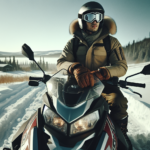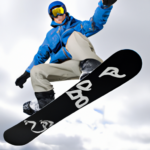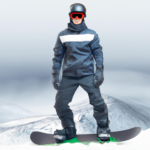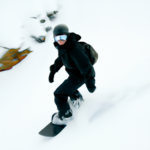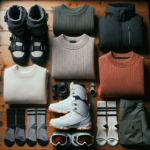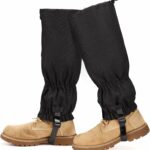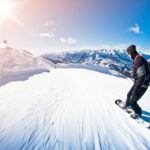Snowboarding is all about exhilarating runs, gravity-defying tricks, and non-stop thrills. But whether you’re already tearing up the slopes or about to embark on your first snowboarding adventure, it’s important to remember – your fabulous performance also depends on suitable gear, particularly the right clothing. So, “How to Properly Dress for Snowboarding?” presents an expert guide to assembling a well-dressed, weather-resistant, and warm outfit for your upcoming snowboarding escapade. It takes you through essential considerations from headwear and eyewear to base layers, outerwear, and even underwear. Ultimately, it empowers you to select the ideal attire that ensures both comfort and safety, enabling you to push your limits without the fear of frostbite or hypothermia! So get ready to hit the snow in style, fully prepared for everything Mother Nature might throw your way.
Understanding Snowboarding Climate and Weather
When it comes to snowboarding, one thing that significantly influences your experience is the weather. Understanding the variation in weather conditions can transform your snowboarding experience from being merely average to exceptional. Weather variations can range from a sunny and mild winter day, to blizzard conditions with heavy snowfall, gusty wind, and sub-zero temperatures. These variations can dramatically impact visibility, snow quality, and your overall comfort while on the slopes.
Variations in Weather Conditions
Weather variations are indeed the most unpredictable aspect of snowboarding. While one day might be sunny with great visibility and soft powder snow, another might consist of freezing temperatures with icy or slushy conditions. Therefore, being prepared for a diverse range of weather conditions is crucial for your comfort and safety.
Climate Characteristics of Popular Snowboarding Locations
Each snowboarding location has its unique climate characteristics. For example, the snow in the Alps often contrasts to those in the Rockies. Some areas might consistently experience heavy snowfall, while others have bone-chilling winds. Understanding the climate of your chosen destination will help you plan and pack the most suitable attire for your snowboarding adventure.
How Weather Affects Snowboarding Attire
The weather significantly determines your choice of snowboarding attire. On warmer days, you may only need a light jacket or vest over your base layer, paired with a breathable, light pair of snowboarding pants. But on colder days, additional layers, snow-proof outerwear, insulated gloves, and other cold-weather accessories will be essential.
Base Layers for Snowboarding
Your snowboarding ensemble starts with the base layers. These are the clothes worn directly against your skin and play a vital role in managing body moisture and retaining heat.
Importance of Thermal Underwear
Thermal underwear, also known as long johns, is an essential part of your base layer. They provide an extra layer of insulation to help keep your body heat from escaping and prevent cold air from reaching your skin, keeping you warm on even the coldest of days on the slopes.
Material Options for Base Layers
When it comes to base layers, the material can either make or break your comfort on the slopes. Cotton, for example, isn’t ideal as it absorbs moisture and takes a long time to dry. Synthetic materials like polyester, or natural fibers such as merino wool are much more effective, offering optimal moisture-wicking properties.
Benefits of Moisture-Wicking Fabrics
The essential function of base layers is to wick or draw moisture away from your skin. Moisture-wicking fabrics move sweat to the external surface of the material where it can evaporate, keeping you dry and comfortable in the process. Being dry means you stay warmer when it’s cold, and cooler when it’s hot.
Mid Layers for Insulation
Mid layers are all about insulation. The purpose of this layer is to trap warm air, provide additional heat, and add comfort during cold days on the slope.
Role of Mid Layers
Located between your base layer and your outer layer, mid layers are the primary insulators of your outfit. By trapping a layer of warm air next to your body, the mid layer keeps the cold air from reaching your skin, keeping you warm.
Choosing the Right Insulation Material
Fleece and down are popular materials for mid layers due to their excellent insulating properties. However, understand that not all mid layers are created equal. Be conscious of the conditions you’ll be boarding in, and select a mid layer that’s suitable for those conditions.
Examples of Effective Mid-Layer Pieces
Effective mid-layer pieces include fleece jackets, softshell jackets, and vests. These can be easily added or removed throughout your day of snowboarding to regulate your body temperature and comfort level.
Snowboarding Pants and Jackets
Your snowboarding pants and jacket are the keys to maintaining warmth and dryness. They serve as the final layer of defense against harsh weather conditions and can offer both insulation and protection against the elements.
Key Features of Snowboarding Pants and Jackets
Essential features of snowboarding outerwear include moisture-wicking abilities, breathability, waterproofing, windproofing, and insulation. Additional features such as snow skirts, pit vents, and plenty of pockets can also enhance functionality on the slopes.
Difference Between Insulated and Shell Options
Snowboarding pants and jackets come in insulated and shell versions. Insulated options have built-in layers of insulation for extra warmth. In contrast, shell jackets are lighter, more suitable for warmer days, and aim to protect against wind and water.
What to Look for in Terms of Waterproofing and Breathability
When choosing your outerwear, look for high waterproof ratings to ensure you stay dry in snowy or rainy conditions. Breathability is also crucial to allow moisture and sweat to escape, keeping you comfortable while active.
Snowboarding Socks
Your snowboarding socks can play a surprisingly significant role in your overall comfort and performance on the slopes.
Importance of Proper Snowboarding Socks
The right pair of socks can keep your feet warm, dry, and comfortable. They can also help enhance the fit of your boots and prevent blisters.
Materials and Thickness Considerations
It’s best to avoid cotton socks as they tend to get wet and stay wet. Opt for wool or synthetic materials that can wick moisture away. The thickness of your socks depends on your preference and the fit of your boots – thicker doesn’t necessarily mean warmer.
How to Avoid Blisters and Cold Feet
Choose socks fitted properly and pair them with boots that match your foot shape and size. Changing into a fresh pair of socks each day can also help prevent blisters and keep your feet warm.
Snowboarding Gloves
Gloves can affect your comfort and performance on the slopes just as much as any other piece of clothing.
Selecting the Right Pair of Gloves
When selecting gloves, consider factors such as insulation, waterproofing, durability, and overall fit. You want a pair that keeps your hands warm and dry and won’t fall apart after a few uses.
Features of Snowboarding-Specific Gloves
Snowboarding-specific gloves often come with unique features such as wrist guards, touchscreen compatibility, and separate liners for added warmth and flexibility.
How to Care for and Maintain Your Gloves
To prolong the lifespan of your gloves, rinse them in cold water after each snowboarding trip, and let them air dry. Avoiding prolonged exposure to direct sunlight will also help maintain their shape and function.
Protective Gear
When snowboarding, your safety should always be a priority.
Importance of Helmets and Goggles
Helmets are essential for protecting your head from potential injuries. Similarly, goggles shield your eyes from the bright sun, wind, and snow, and enhance your visibility on the slopes.
Choosing the Right Helmet and Goggle Size
Your helmet should fit snugly without feeling too tight, and your goggles should sit well with your helmet without any gaps. Both should be adjustable for a personalized fit.
Additional Protective Gear Options
Additional snowboarding protective gear includes wrist guards, padded shorts, and spine protectors. These are not necessary for everyone but can offer extra safety, especially for beginners or those tackling more challenging terrains.
Caring for Your Snowboarding Attire
Proper care and maintenance can help your snowboarding attire last for many seasons.
How to Clean and Store Your Gear
In general, you should clean your gear according to the manufacturer’s instructions, let it air dry, and store it in a cool, dry place.
Repairing Minor Damages
Minor damages such as small rips and tears can be repaired using a fabric patch or sewing kit.
When to Replace Certain Items
Any gear that’s no longer functioning as it should or becomes uncomfortable to wear is due for replacement.
Dressing in Layers for Different Weather Conditions
Layering allows you to adjust your body temperature accordingly during a day on the slopes.
How to Dress for Sunny, Cold, and Snowy Conditions
For sunny conditions, opt for lighter and more breathable layers. Cold conditions call for heavier, insulated clothing. In snowy conditions, waterproofing becomes crucial.
Balancing Warmth and Mobility
While it’s essential to stay warm, it’s equally important not to restrict your mobility. Layers should provide warmth without being so bulky that they limit your movements.
Adjusting Layers Throughout the Day
As weather conditions can change during the day, be prepared to adjust your layers accordingly.
Common Dressing Mistakes to Avoid
When dressing for snowboarding, avoid some common mistakes.
Overlooking the Importance of Layering
Layering is a fundamental aspect of comfortable and safe snowboarding attire. Overlooking this can lead to discomfort and even hypothermia.
Wearing Cotton Clothing
Cotton retains moisture and can leave you feeling cold and wet. Opt for moisture-wicking fabrics instead.
Ignores the Details of Snowboarding Boots, Helmets, and Goggles
Never overlook your boots, helmet, and goggles. They influence your safety, comfort, and performance on the slopes.
In conclusion, the secret to dressing adequately for snowboarding involves understanding weather conditions, selecting the right clothing materials, emphasizing layering, and giving due consideration to each piece of your attire. Invest time in choosing the right gear, and you’ll make your snowboarding adventures safer and more enjoyable.
- What Snowboard Bindings Should I Get? - January 23, 2024
- What Size Screws For Snowboard Bindings? - January 23, 2024
- How To Snowmobile On Water? - January 23, 2024

